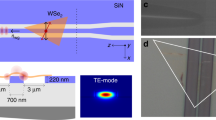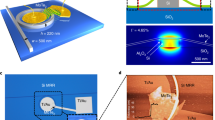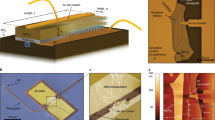Abstract
One of the current challenges in photonics is developing high-speed, power-efficient, chip-integrated optical communications devices to address the interconnects bottleneck in high-speed computing systems1. Silicon photonics has emerged as a leading architecture, in part because of the promise that many components, such as waveguides, couplers, interferometers and modulators2, could be directly integrated on silicon-based processors. However, light sources and photodetectors present ongoing challenges3,4. Common approaches for light sources include one or few off-chip or wafer-bonded lasers based on III–V materials, but recent system architecture studies show advantages for the use of many directly modulated light sources positioned at the transmitter location5. The most advanced photodetectors in the silicon photonic process are based on germanium, but this requires additional germanium growth, which increases the system cost6. The emerging two-dimensional transition-metal dichalcogenides (TMDs) offer a path for optical interconnect components that can be integrated with silicon photonics and complementary metal-oxide-semiconductors (CMOS) processing by back-end-of-the-line steps7,8,9. Here, we demonstrate a silicon waveguide-integrated light source and photodetector based on a p–n junction of bilayer MoTe2, a TMD semiconductor with an infrared bandgap10. This state-of-the-art fabrication technology provides new opportunities for integrated optoelectronic systems.
This is a preview of subscription content, access via your institution
Access options
Access Nature and 54 other Nature Portfolio journals
Get Nature+, our best-value online-access subscription
$29.99 / 30 days
cancel any time
Subscribe to this journal
Receive 12 print issues and online access
$259.00 per year
only $21.58 per issue
Buy this article
- Purchase on Springer Link
- Instant access to full article PDF
Prices may be subject to local taxes which are calculated during checkout




Similar content being viewed by others
References
Miller, D. A. B. Device requirements for optical interconnects to silicon chips. Proc. IEEE 97, 1166–1185 (2009).
Reed, G. T. in Silicon Photonics: The State of the Art 15–145 (Wiley, 2008).
Pyatkov, F. et al. Cavity-enhanced light emission from electrically driven carbon nanotubes. Nat. Photon. 10, 420–427 (2016).
Birowosuto, M. D. et al. Movable high-Q nanoresonators realized by semiconductor nanowires on a Si photonic crystal platform. Nat. Mater. 13, 279–285 (2014).
Bergman, K., Carloni, L. P., Biberman, A., Chan, J. & Hendry, G. Photonic Network-on-Chip Design (Springer, 2014).
Famà, S., Colace, L., Masini, G., Assanto, G. & Luan, H.-C. High performance germanium-on-silicon detectors for optical communications. Appl. Phys. Lett. 81, 586–588 (2002).
Wang, L. et al. One-dimensional electrical contact to a two-dimensional material. Science 342, 614–617 (2013).
Zhou, L. et al. Large-area synthesis of high-quality uniform few-layer MoTe2 . J. Am. Chem. Soc. 137, 11892–11895 (2015).
Kang, K. et al. High-mobility three-atom-thick semiconducting films with wafer-scale homogeneity. Nature 520, 656–660 (2015).
Ruppert, C., Aslan, O. B. & Heinz, T. F. Optical properties and band gap of single- and few-layer MoTe2 crystals. Nano Lett. 14, 6231–6236 (2014).
Shacham, A., Bergman, K. & Carloni, L. P. Photonic networks-on-chip for future generations of chip multiprocessors. IEEE Trans. Comput. 57, 1246–1260 (2008).
Borkar, S. & Chien, A. A. The future of microprocessors. Commun. ACM 54, 67–77 (2011).
Liu, M. et al. A graphene-based broadband optical modulator. Nature 474, 64–67 (2011).
Pospischil, A., Furchi, M. M. & Mueller, T. Solar-energy conversion and light emission in an atomic monolayer p–n diode. Nat. Nanotech. 9, 257–261 (2014).
Baugher, B. W. H., Churchill, H. O. H., Yang, Y. & Jarillo-Herrero, P. Optoelectronic devices based on electrically tunable p–n diodes in a monolayer dichalcogenide. Nat. Nanotech. 9, 262–267 (2014).
Ross, J. S. et al. Electrically tunable excitonic light-emitting diodes based on monolayer WSe2 p–n junctions. Nat. Nanotech. 9, 268–272 (2014).
Palacios, T. Graphene electronics: thinking outside the silicon box. Nat. Nanotech. 6, 464–465 (2011).
Fiori, G. et al. Electronics based on two-dimensional materials. Nat. Nanotech. 9, 768–779 (2014).
Ferrari, A. C. et al. Science and technology roadmap for graphene, related two-dimensional crystals, and hybrid systems. Nanoscale 7, 4598–4810 (2015).
Naylor, C. H. et al. Monolayer single-crystal 1T′-MoTe2 grown by chemical vapor deposition exhibits weak antilocalization effect. Nano Lett. 16, 4297–4304 (2016).
Kim, S. M. et al. Synthesis of large-area multilayer hexagonal boron nitride for high material performance. Nature Commun. 6, 8662 (2015).
Ma, D. et al. A universal etching-free transfer of MoS2 films for applications in photodetectors. Nano Res. 8, 3662–3672 (2015).
Lezama, I. G. et al. Indirect-to-direct band gap crossover in few-layer MoTe2 . Nano Lett. 15, 2336–2342 (2015).
Robert, C. et al. Excitonic properties of semiconducting monolayer and bilayer MoTe2 . Phys. Rev. B 94, 155425 (2016).
Banwell, T. & Jayakumar, A. Exact analytical solution for current flow through diode with series resistance. Electron. Lett. 36, 291–292 (2000).
Ross, J. S. et al. Electrical control of neutral and charged excitons in a monolayer semiconductor. Nat. Commun. 4, 1474 (2013).
Froehlicher, G., Lorchat, E. & Berciaud, S. Direct versus indirect band gap emission and exciton–exciton annihilation in atomically thin molybdenum ditelluride MoTe2 . Phys. Rev. B 94, 085429 (2016).
Hai, H. et al. Highly sensitive visible to infrared MoTe2 photodetectors enhanced by the photogating effect. Nanotechnology 27, 445201 (2016).
Yin, L. et al. Ultrahigh sensitive MoTe2 phototransistors driven by carrier tunneling. Appl. Phys. Lett. 108, 043503 (2016).
Octon, T. J., Nagareddy, V. K., Russo, S., Craciun, M. F. & Wright, C. D. Fast high-responsivity few-layer MoTe2 photodetectors. Adv. Opt. Mater. 4, 1750–1754 (2016).
Akahane, Y., Asano, T., Song, B.-S. & Noda, S. Fine-tuned high-Q photonic-crystal nanocavity. Opt. Express 13, 1202–1214 (2005).
Shiue, R.-J. et al. High-responsivity graphene–boron nitride photodetector and autocorrelator in a silicon photonic integrated circuit. Nano Lett. 15, 7288–7293 (2015).
Zomer, P. J., Guimarães, M. H. D., Brant, J. C., Tombros, N. & van Wees, B. J. Fast pick up technique for high quality heterostructures of bilayer graphene and hexagonal boron nitride. Appl. Phys. Lett. 105, 013101 (2014).
Acknowledgements
The authors acknowledge helpful discussions with R.J. Shiue, H. Churchill, Q. Ma, Y. Lin and E. Sie and measurement help from J. Carr and M. Bawendi. This work was primarily supported by the Center for Excitonics, an Energy Frontier Research Center funded by the US Department of Energy (DOE), Office of Science, Office of Basic Energy Sciences, under award no. DESC0001088 (Y.Q.B., G.G., D.K.E., M.M.F., E.N.-M., J.K., D.E. and P.J.-H.). Experimental measurements were partially supported by the National Science Foundation (NSF) under award DMR-1405221 (Y.C.). This work made use of the Materials Research Science and Engineering Center Shared Experimental Facilities supported by the National Science Foundation (DMR-0819762) and Harvard's Center for Nanoscale Systems, supported by the NSF (ECS-0335765). G.G. acknowledges support by the Swiss National Science Foundation (SNSF). M.H. acknowledges support from the Danish Council for Independent Research (DFF: 1325-0014). M.M.F. acknowledges financial funding by the Austrian Science Fund (START Y-539). J.Z. acknowledges partial support from the Office of Naval Research (N00014-13-1-0316). This research used resources of the Center for Functional Nanomaterials, which is a US DOE Office of Science User Facility, at Brookhaven National Laboratory, under contract no. DE-SC0012704. K.W. and T.T. acknowledge support from the Elemental Strategy Initiative conducted by the MEXT, Japan, and JSPS KAKENHI grant nos. JP15K21722 and JP25106006.
Author information
Authors and Affiliations
Contributions
Y.Q.B., D.E. and P.J.-H. conceived the experiment. Y.Q.B., J.Z., E.N.-M. and L.Z. fabricated the samples. Y.Q.B., G.G., M.M.F., Y.C. and D.B. performed the measurements. M.H. simulated the photonic crystal waveguide. L.Z. and D.K.E. participated in early discussions and experiments. T.T. and K.W. grew the crystals of hexagonal boron nitride. J.K., D.E. and P.J.-H. advised on the experiments and data analysis. All authors discussed the results and commented on the manuscript.
Corresponding authors
Ethics declarations
Competing interests
The authors declare no competing financial interests.
Supplementary information
Supplementary information
Supplementary information (PDF 1949 kb)
Rights and permissions
About this article
Cite this article
Bie, YQ., Grosso, G., Heuck, M. et al. A MoTe2-based light-emitting diode and photodetector for silicon photonic integrated circuits. Nature Nanotech 12, 1124–1129 (2017). https://doi.org/10.1038/nnano.2017.209
Received:
Accepted:
Published:
Issue Date:
DOI: https://doi.org/10.1038/nnano.2017.209
This article is cited by
-
Reconfigurable logic and in-sensor encryption operations in an asymmetrically tunable van der Waals heterostructure
Nano Research (2024)
-
Tunable near-infrared light emission from layered TiS3 nanoribbons
Frontiers of Physics (2024)
-
Temperature-dependent failure of atomically thin MoTe2
Journal of Molecular Modeling (2024)
-
Phase-controlled van der Waals growth of wafer-scale 2D MoTe2 layers for integrated high-sensitivity broadband infrared photodetection
Light: Science & Applications (2023)
-
Ferroelectric-defined reconfigurable homojunctions for in-memory sensing and computing
Nature Materials (2023)



